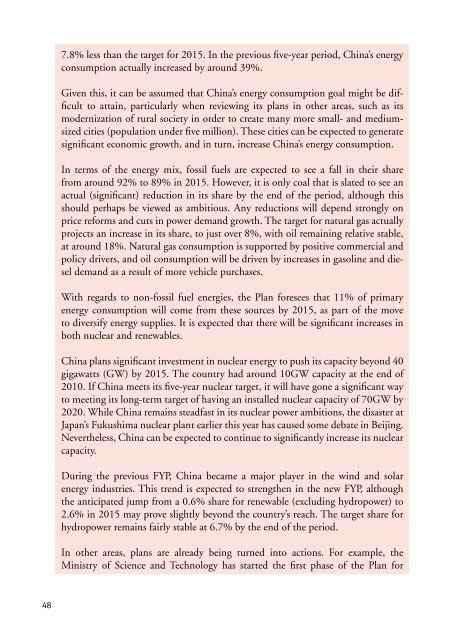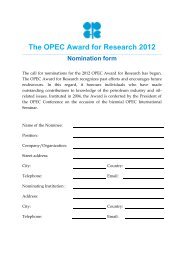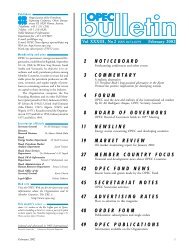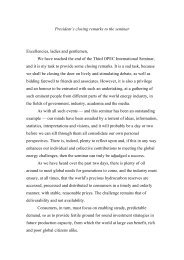Section One
Section One
Section One
Create successful ePaper yourself
Turn your PDF publications into a flip-book with our unique Google optimized e-Paper software.
48<br />
7.8% less than the target for 2015. In the previous five-year period, China’s energy<br />
consumption actually increased by around 39%.<br />
Given this, it can be assumed that China’s energy consumption goal might be difficult<br />
to attain, particularly when reviewing its plans in other areas, such as its<br />
modernization of rural society in order to create many more small- and mediumsized<br />
cities (population under five million). These cities can be expected to generate<br />
significant economic growth, and in turn, increase China’s energy consumption.<br />
In terms of the energy mix, fossil fuels are expected to see a fall in their share<br />
from around 92% to 89% in 2015. However, it is only coal that is slated to see an<br />
actual (significant) reduction in its share by the end of the period, although this<br />
should perhaps be viewed as ambitious. Any reductions will depend strongly on<br />
price reforms and cuts in power demand growth. The target for natural gas actually<br />
projects an increase in its share, to just over 8%, with oil remaining relative stable,<br />
at around 18%. Natural gas consumption is supported by positive commercial and<br />
policy drivers, and oil consumption will be driven by increases in gasoline and diesel<br />
demand as a result of more vehicle purchases.<br />
With regards to non-fossil fuel energies, the Plan foresees that 11% of primary<br />
energy consumption will come from these sources by 2015, as part of the move<br />
to diversify energy supplies. It is expected that there will be significant increases in<br />
both nuclear and renewables.<br />
China plans significant investment in nuclear energy to push its capacity beyond 40<br />
gigawatts (GW) by 2015. The country had around 10GW capacity at the end of<br />
2010. If China meets its five-year nuclear target, it will have gone a significant way<br />
to meeting its long-term target of having an installed nuclear capacity of 70GW by<br />
2020. While China remains steadfast in its nuclear power ambitions, the disaster at<br />
Japan’s Fukushima nuclear plant earlier this year has caused some debate in Beijing.<br />
Nevertheless, China can be expected to continue to significantly increase its nuclear<br />
capacity.<br />
During the previous FYP, China became a major player in the wind and solar<br />
energy industries. This trend is expected to strengthen in the new FYP, although<br />
the anticipated jump from a 0.6% share for renewable (excluding hydropower) to<br />
2.6% in 2015 may prove slightly beyond the country’s reach. The target share for<br />
hydropower remains fairly stable at 6.7% by the end of the period.<br />
In other areas, plans are already being turned into actions. For example, the<br />
Ministry of Science and Technology has started the first phase of the Plan for
















